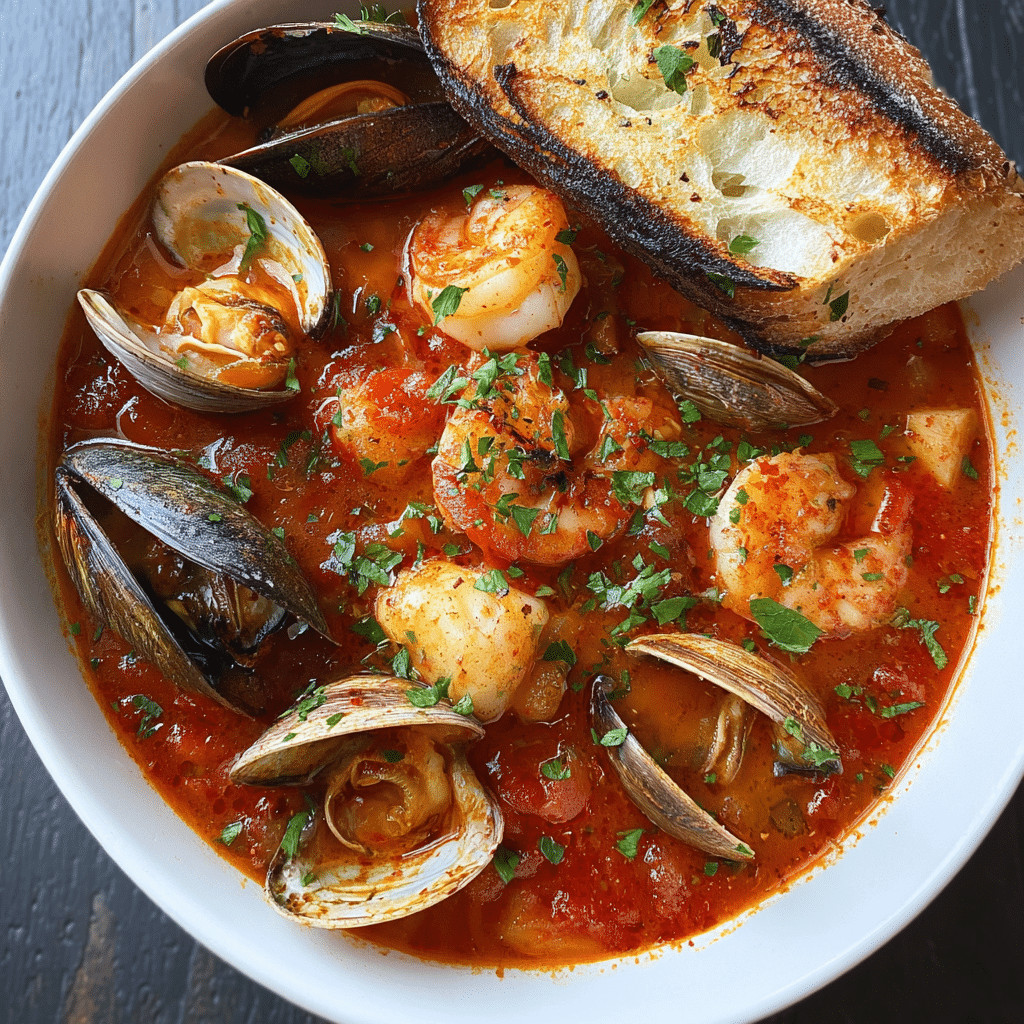The History and Origin of Cioppino
Cioppino is a classic seafood stew that traces its roots to the foggy shores of San Francisco in the late 1800s. Created by Italian immigrant fishermen—primarily those from Genoa, Italy—this comforting, tomato-based dish was developed as a way to use the day’s catch in a flavorful, communal meal. The name “Cioppino” likely comes from the Italian dialect word ciuppin, meaning “to chop” or “to make soup from leftovers.” It was a practical, frugal solution, using scraps of seafood and whatever ingredients were on hand, turning them into a deeply satisfying and nourishing meal.
Traditionally, cioppino was made right on the fishing boats. The fishermen would contribute their leftover catch—clams, mussels, shrimp, crab, white fish—and simmer them in a pot with tomatoes, garlic, onions, wine, and herbs. Over time, this rustic dish gained popularity beyond the docks and was adopted by restaurants across San Francisco’s famed Fisherman’s Wharf, where it became a culinary symbol of the city’s seafood legacy.
Cultural Significance and Culinary Identity
What makes cioppino particularly unique is how it embodies a fusion of Italian heritage and Californian abundance. It’s not a dish you’ll typically find in Italy; it is distinctly Italian-American—a hybrid born from necessity, creativity, and the vibrant seafood culture of the West Coast. Much like gumbo in Louisiana or clam chowder in New England, cioppino is deeply regional. It tells a story of place, people, and the spirit of community.
In many households, cioppino has become a celebratory dish. It’s often enjoyed around the holidays or on special occasions when families gather, particularly during Christmas Eve’s Feast of the Seven Fishes. Its festive mix of colors, aromas, and textures brings warmth and joy to the table, making it an unforgettable centerpiece for any dinner.
Flavor Profile and Key Characteristics
Cioppino is a dish that balances boldness and elegance. At its core, the broth is what defines it—rich, fragrant, and layered. Crushed tomatoes provide depth and body, while white wine adds acidity and brightness. Garlic and onions infuse it with warmth, and herbs like oregano and basil bring aromatic complexity. The optional use of red pepper flakes offers a gentle heat that cuts through the brininess of the seafood.
But the true stars are the shellfish and fish. Mussels, clams, shrimp, scallops, and flaky white fish each contribute their own textures and flavors. As they simmer in the tomato-wine broth, they release their juices, enriching the stew and marrying everything into one harmonious blend. The result is a slightly spicy, deeply savory dish that captures the essence of the sea in every bite.
Serving Suggestions and Pairings
Cioppino is best served piping hot in wide, shallow bowls to accommodate the generous mix of seafood. A classic pairing is a slice—or several—of toasted sourdough bread, ideally rubbed with garlic or lightly buttered. This bread is not just a side—it’s a crucial part of the experience. Dipping into the tomato-rich broth and scooping up bits of tender fish or shrimp is one of the most satisfying parts of the meal.
For drinks, a crisp, dry white wine such as Sauvignon Blanc or Pinot Grigio complements the acidity and seafood notes beautifully. Alternatively, a light red wine like a Chianti or Pinot Noir can also pair well, especially if the broth has a stronger tomato base. For those who prefer beer, a pilsner or Belgian-style wheat beer can offer a refreshing contrast to the stew’s bold flavors.
Add a simple green salad dressed with lemon vinaigrette to balance the richness, and you have a well-rounded, restaurant-worthy meal at home.
Modern Twists and Ingredient Flexibility
One of the best aspects of cioppino is how adaptable it is. The traditional recipe calls for a medley of shellfish and white fish, but you can easily tailor it to what’s available at your local fish market or to suit dietary preferences. Don’t have mussels or clams? Double up on shrimp or add crab legs. Prefer spicy over mild? Add more chili flakes or even a splash of hot sauce. Want a lower-carb version? Serve it without bread and bulk it up with extra seafood or vegetables like fennel and kale.
Vegetarians can even enjoy a “landlocked cioppino” made with hearty mushrooms, chickpeas, and seaweed for a briny undertone. The base—aromatic tomatoes, garlic, wine, and herbs—remains just as comforting and flavorful.
Why Cioppino is a Perfect Dinner Party Dish
Cioppino is ideal for entertaining. Not only does it look impressive with its colorful mix of seafood, but it’s also relatively simple to make. The broth can be prepared in advance, allowing you to focus on cooking the seafood just before serving. It’s a dish that invites conversation, shared moments, and communal enjoyment. The sight of a steaming pot of cioppino placed at the center of the table evokes the feeling of abundance and care—a generous offering for those you love.
Plus, it’s an all-in-one meal that doesn’t require multiple side dishes. With one pot and a few pieces of bread, you’ve created a feast. It accommodates various dietary preferences, is gluten-free by nature (bread aside), and offers high-quality protein and healthy fats.
Storage and Leftover Tips
While cioppino is best enjoyed fresh, you can store any leftover broth and seafood in an airtight container in the refrigerator for up to 2 days. However, seafood tends to toughen when reheated, so it’s best to reheat gently over low heat without bringing it to a boil. If you expect leftovers, you can store the broth and seafood separately, combining them only when reheating to preserve the texture of the shellfish and fish.
Freezing is not generally recommended due to the delicate nature of cooked seafood, but the tomato base alone can be frozen for up to 3 months. When ready to use, simply reheat the broth and add fresh seafood to finish.
Conclusion: The Soul of the Sea in One Bowl
Cioppino is more than a meal—it’s an experience, a slice of culinary history, and a celebration of both tradition and innovation. It reflects the values of sustainability, community, and creativity that defined the lives of early immigrants in San Francisco. And it continues to bring people together today with its rich flavors and communal spirit.
Whether you’re discovering cioppino for the first time or rekindling a memory from a coastal vacation or a family celebration, this stew invites you to slow down and savor. Every bite offers a journey through old-world flavors and new-world comfort. Make it your own, serve it with love, and let it be a centerpiece of many memorable meals to come.






